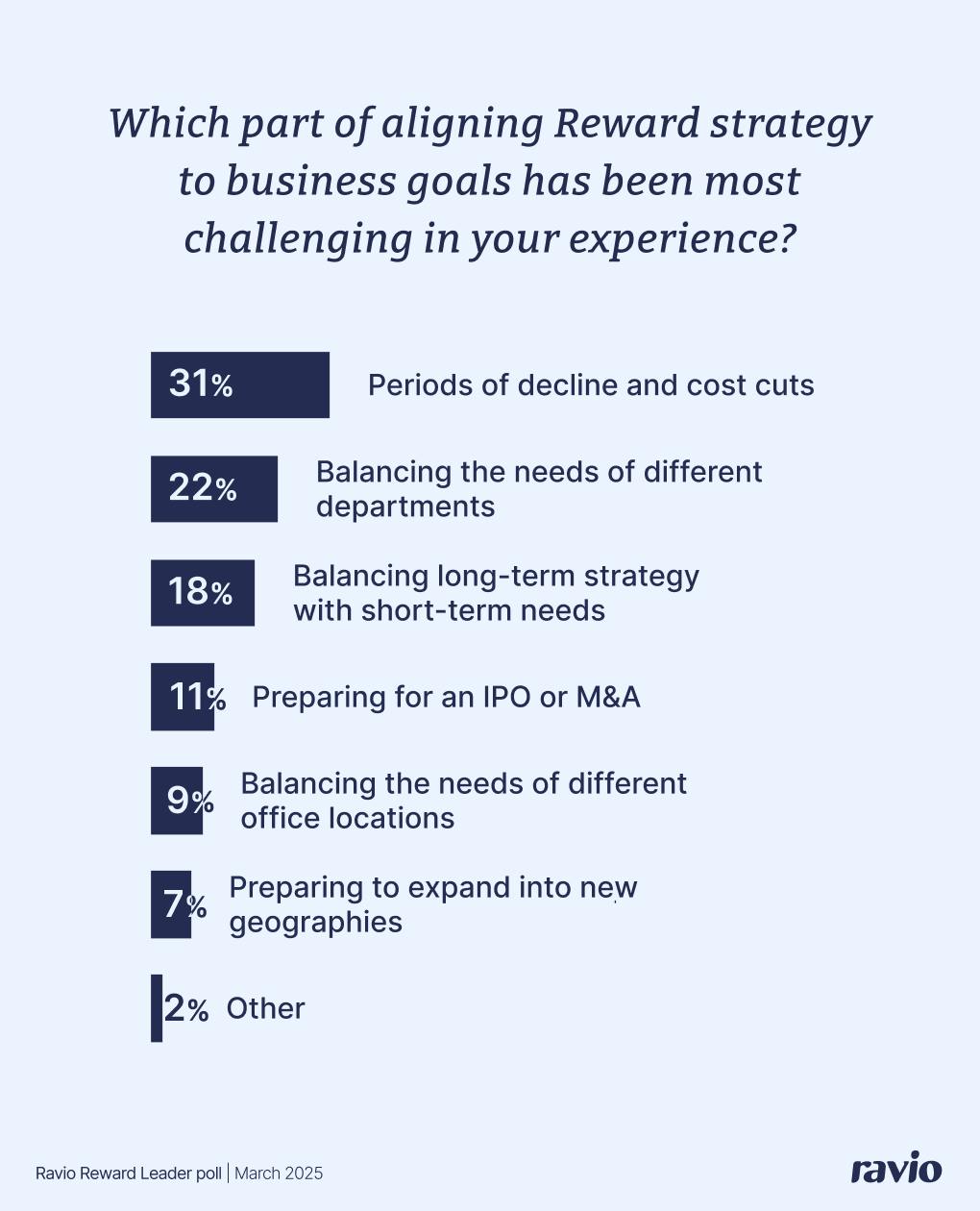Employee compensation has a direct impact on a company’s bottom line.
Payroll is typically the biggest cost in a company’s outgoings, accounting for 70% of operating expenses. Ensuring that those payroll costs are used effectively as a lever for hiring, retaining, and motivating the best employees to drive progress towards priority goals, is crucial for company performance.
But designing a compensation strategy that will deliver business results is no easy task.
So we asked the experts: Anastasia Efremova, Global Director of Total Reward at Semrush, Figen Zaim, Founder and Managing Consultant at Olivier Reward Consulting, and Vaso Parisinou, Chief People Officer at Ravio.
Let’s find out how they do it.

Subscribe to our newsletter for monthly insights from our compensation dataset and network of experts, to help you navigate a career in Rewards 📩
Tailor the compensation strategy to your company’s unique context
All of our experts highlighted that designing a bespoke compensation strategy, closely aligned to the values, culture, and business goals of an individual organisation, is non-negotiable if you want to drive tangible business results.
Anastasia experienced this herself when moving from Head of Compensation & Benefits at Ilim Group to a new role as Global Director of Total Rewards at Semrush.
“I’d been working in the manufacturing space, so Semrush was a completely new industry for me,” Anastasia explains, “and the business was also in the midst of a rapid growth phase, which was new territory for me too.”
“Semrush needed a compensation strategy in place to guide this growth trajectory, but I quickly found that I needed to unlearn everything that I thought I knew from my previous company’s strategy, and start from scratch – you can’t copy-paste company culture, and you can’t copy-paste compensation either.”
For Figen, working as a Total Rewards consultant means she understands better than most that a one-size-fits-all approach doesn’t work. “We often have founders come to us asking for ‘something quick, off the shelf’,” she says, “and my team have to explain to them that there’s no such thing as ‘off the shelf’ in compensation strategy – it has to be tailored to the company to have any chance at success.”
So how do you go about tailoring the compensation strategy? In-depth conversations with leadership stakeholders to understand the company’s needs is the place to start.
“It’s important to understand the DNA of the business,” says Figen.
Start by understanding the business strategy and culture – why does the company exist? What does it stand for? What is the future vision for the business? What kind of culture and workplace do they believe is right for the company? And so on.
“All of this has to be translated into the compensation strategy,” Figen explains, “because business strategy and compensation strategy should be intrinsically tied and evolve hand-in-hand, so that you can’t change one without changing the other.”
💡 Compensation strategy examples: How Patagonia and Ravio reflect their company missions in employee Rewards
Vaso shared two examples with us to illustrate how compensation can reflect the unique culture and values of a company.
Firstly, Patagonia.
Their mission statement is “we’re in business to save our home planet”, and their compensation strategy reflects their environmental values.
For instance, all employees are able to take ‘activism hours’ as additional paid time off, to volunteer for environmental causes. Patagonia has also committed to covering legal costs for employees who are arrested during protests through a ‘bail policy’.
Secondly, Ravio.
At Ravio we live and breathe compensation. It’s our product, and our team is well-versed in how it all works behind-the-scenes, including having access to our global market benchmarking data.
It’s extra important that our own compensation strategy at Ravio is well-defined and clearly communicated to ensure we practice what we preach and give our team the clarity they want.
Because of this, Vaso has developed a compensation strategy that’s more akin to what you’d normally see at a 500-person mature company than a 50-person startup – and we’ll be sharing more about our approach this year.
Be ready to defend the strategy to C-suite
Getting C-suite leaders to understand the strategic importance of compensation and buy-in to the strategy development process can be an uphill battle.
We polled attendees of our Reward Office Hours in March 2025 to see whether their leadership teams understand the strategic importance of compensation, and it was clear that this isn’t typically the case – only 16% of respondents feel their leaders ‘completely get it’.

For Anastasia, language can show alignment.
“Rewards is the HR function that has the most tangible impact on business performance,” she says, “but that’s sometimes undermined because we don’t use language that aligns with how leaders think about impact.”
“Instead of coming to them with data on ‘employee engagement’ or ‘talent density’ we need to be talking about ‘net income’ or ‘revenue growth’ – or really whatever metrics your C-suite is using to measure success.”
Vaso’s career has included building the People and Rewards function for several high-growth startups. She’s found that founder-leaders tend to be “very opinionated about compensation” so getting their buy-in is important.
Vaso outlined a two-step approach that she’s found to be effective:
- Empathetic listening
- Data-driven storytelling
First sit down with your founders and leaders and ask them a ton of questions. This should cover the vision, values, goals, and priorities of the business. It should also cover the priorities and concerns for each stakeholder as an individual.
“Compensation tends to be an area that leaders are very opinionated about,” Vaso explains, “different people having different perspectives on how employees should be compensated and incentivised and you need to unearth those perspectives first.”
“I’ve found that focusing on listening and empathising with their viewpoint and their concerns helps stakeholders feel heard and helps me understand much more deeply what they’re trying to achieve – and, therefore, the principles I need to reflect in the compensation strategy,” she says.
Then, use data to demonstrate how compensation can be used to achieve the priorities they’ve highlighted or to mitigate the concerns they’ve shared.
“Tell a really strong story about how compensation connects with those top business priorities,” Vaso says.
She also shared a top tip of hers: “Find an ally in the marketing team. I’ve found internal communications or content colleagues to be really helpful in shaping the right narrative for leadership.”
Think global, act local
Whilst a compensation strategy aims to ensure that every compensation decision is made with the same principles and structure in mind, it’s also important to allow for flexibility and nuance in different parts of the business – especially for larger companies.
“It’s crucial that the compensation strategy outlines an overarching framework and structure to compensation,” Anastasia says, “but how that strategy is actually implemented across the business might vary from location to location or department to department.”
“The core principles or philosophy remains the same, but we’re able to adapt to the different needs of different markets,” she says, “I think of it as ‘think global, act local’.”
For Vaso, this approach also helps to give departments ownership over employee compensation.
“The strategy is there to guide decisions, but you always have to listen to your stakeholders and act thoughtfully based on their needs,” Vaso says.
“If a Head of Sales comes to me and says they need to change the incentive structure for their team, I’ll listen to their needs and concerns, relay back to them the core principles we have in place, and then suggest a solution aligned to their needs and our overarching strategy.”
💡 Compensation strategy example: Global nuances in employee benefits at Semrush
As an example, Anastasia highlighted that at Semrush supporting the physical and mental wellbeing of employees is a core driver of employee benefits, but the benefits offered vary slightly across core locations.
For instance, whilst all employees across the globe benefit from an unlimited paid time off policy to encourage time off work to relax and recharge, only employees in the Prague office are offered a MultiSport card to access gym, sports, and wellness facilities for free – because this is a programme in place solely in the Czech Republic.
Be prepared for short-term shifts in priority
Speaking to all three of our experts, it became clear that navigating shifting contexts and priorities is a crucial part of ensuring a compensation strategy is able to deliver results.
There’s the make up of the role, where Reward Leaders are constantly context switching between strategic direction and day-to-day operations – like having to switch from blue sky thinking about the future of the compensation strategy to fixing a payslip issue that’s come through from an employee to the HR mailbox.
Then there’s the internal context of the company, where changes are needed as a company goes along its journey. There might be a period of growth followed quickly by budget cuts. There might be an office location opening in a new priority market. The company might be preparing for an IPO or M&A. Or there might be a location or department facing particular issues with recruitment or attrition.
And finally there’s the external context of macroeconomic conditions. Outside events like hyperinflation in one of your markets, or even a global pandemic like Covid-19, will have a huge impact on the compensation strategy.
As Figen put it: “Reward Leaders are like octopuses, with eight different tentacles doing eight different things.”
When we polled attendees of our Reward Office Hours in March 2025 about the most challenging periods in their experience, the variance in answers illustrates just how much of a balancing act Rewards can be – managing the day-to-day whilst being flexible enough to adapt when change arises.

For Vaso, community is a powerful tool to handle this.
“I know for myself,” she says, “the one thing that’s kept me grounded during the most challenging periods of my career has been my community of peers.”
“The community is there whenever I need someone who truly gets it – whether it’s to brainstorm solutions to a problem, or simply to commiserate together about challenges that colleagues in different roles simply wouldn’t understand.”
💡Compensation strategy example: Moving from growth to maturity at Semrush
Anastasia shared that Semrush’s overarching compensation strategy was developed in 2023 when she joined the company.
At the time, Semrush was in a phase of rapid growth – a big focus on hiring to grow the team and meet quickly increasing revenue targets.
Now, in 2025, Semrush has moved into a new phase of maturity. There’s still growth (including expanding to new geographies), but it’s less of a steep growth trajectory and more of a sustainable growth phase, aiming to maximise performance within existing teams.
This has brought with it a need to revisit the compensation strategy, particularly including a need to better articulate the relationship between pay and performance at Semrush as the company seeks new ways to incentivise and motivate the team.
In terms of external context, there’s also a shift towards pay transparency and pay equity with new legislation like the EU Pay Transparency Directive being implemented. This has prompted a need for Semrush to define what pay transparency and pay equity looks like for the company.
It’s also been an opportunity to look more generally at the future of work at Semrush too, exploring the needs that the company will have in the near future, and how the compensation strategy can be adapted to support that.



